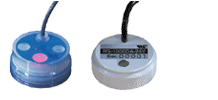PRODUCTS
PHOTOELECTRIC LIQUID SENSORS
Our photoelectric liquid leak and level sensors are designed for wet chemical process equipment, distribution boxes, drip pans, and other equipment using process fluids.
Liquid Level Sensors

Our unique liquid level sensors are designed to sense single or multiple levels in a bath, tank, or drum (e.g. high, low, high-high, high-low) without contamination. Sensors will signal when bath dump is complete. They can also monitor operations of fluid handling of process equipment.
The sensor is mounted to translucent tubing with a bracket and is then adjusted to the desired liquid level. Sensitivity is set via a potentiometer. Fluid levels or bubbles are sensed by refracting light through the liquid in the tubing. The state of operation is signaled by a red/green LED indicator on the base of the sensor. When no liquid is present, the green light is illuminated and the white wire is at 0 volts. With liquid is present, the indicator is red and the yellow wire is at 0 volts.
topLeak Sensors

Our TeflonŽ encapsulated/silicon potted sensors are perfect for applications with mild to highly corrosive or abrasive environments. The Teflon coated bracket is mounted to a horizontal, flat surface. The leak sensor is then clipped into a bracket.
When a leak occurs, the infrared light is interrupted by the liquid, and causes an alarm. The LED indicates the leak by illuminating a red light.
topSignal Conditioning

This power supply and signal conditioning unit is designed for use with up to ten RS-1000 Series Photoelectric Liquid Leak Sensors in one tool. The unit can be used in the same environments as the liquid leak sensors are specified for. The unit is CE marked and UL recognized.
A power rocker switch enables the 24 Volt DC system. Control of the dry contact relay is provided by a SET rocker switch that supplies 5 Volt DC to the sensors. The unit can be ordered with normally open or normally closed relays.
topLiquid Leak and Level Sensor Key Applications
- Wet chemistry process equipment or other process fluids
- Containment of drip pans
- Open or cabinet floor locations
- Chemical distribution boxes
- Overhead secondary containment traps or pipe racks

